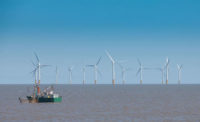Offshore wind projects have faced tremendous resistance in the U.S. For example, a project called Cape Wind, a planned 127-turbine project off the Massachusetts coast, has faced permitting hurdles, political obstacles and lawsuits. What’s more, the five-turbine Fishermen’s Energy wind farm in offshore New Jersey has been hampered by state regulatory rejections over power-cost issues.
The first and only offshore wind farm to start construction in the U.S. is the Block Island Wind Farm, being built by Deepwater Wind off the coast of Rhode Island. A joint venture of Weeks Marine and Manson Construction last summer installed turbine-jacket foundations for the five-turbine, 30-MW first phase. The project is expected to begin generating power by late 2016.
All existing wind farms are located in waters less than 40 meters deep. To take advantage of the stronger winds in locations farther offshore, at least three firms are developing floating wind turbines that can be moored in deeper water.
Norway’s Statoil is planning to develop a 30-MW wind farm consisting of five floating turbines off the coast of Scotland. Seattle-based Principle Power, which has been operating a 2-MW pilot floating turbine off the coast of Portugal since 2011, is planning a 30-MW array off Oregon’s coast. And a consortium of Japanese universities, engineers and contractors is assembling a floating offshore wind-farm demonstration project off the coast of Fukushima.
View the above slide show for a look at the largest-capacity offshore wind farms across the globe.















Post a comment to this article
Report Abusive Comment